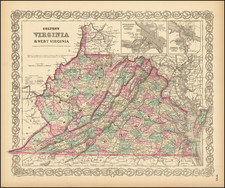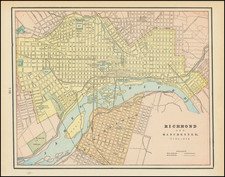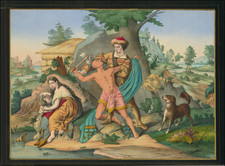Early Native Virginians
This woodcut depicts two native Virginians. The accompanying text provides a detailed description of the lifestyle, culture, and practices of the indigenous peoples of Virginia.
The image appeared in Happel's Thesaurus Exoticorum, published in Hamburg in 1688.
The following is a rough translation of the text:
"Virginia is also a wonderful land, rich in fruits, fish, animals, birds, and beautiful meadows. The inhabitants mostly live by rivers or streams and in low bushes, so they are sufficiently provided with drinking water and firewood. They ignite fire using a dry sharp piece of wood, which they forcefully spin in a square hole of another wood. Their homes, made from young branches and rods of trees as well as tightly woven mats and bast, smoke very heavily, even though there's a smoke hole in the middle of the roof. Nevertheless, they are quite strong and can endure against weather and wind for a long time. In their homes, they lay around the fire on heaps and reed tubes, covered with mats, sometimes up to twenty people.
Most of these houses stand in the middle of their courtyards, which are small pieces of land; often a hundred or more are located together, only separated from each other by narrow rows of trees. As soon as the children are born, the mothers wash or bathe them, even in the coldest winter times, in the rivers and smear them with a red color made from the root Pockone and tar, so they could get such hard skin, which can't be affected by heat, cold, or any other discomfort of the weather.
Both men and women have their particular tasks they perform, and no others, especially men who are so cautious that they would rather stay idle than to take on another job, which they believe does not suit them. Thus, the female population, along with children, takes care of the cows, provides for farming; breaks the corn into pieces or grinds it small; bakes bread, carries burdens, makes mats, baskets, pots, and mortars; Indeed, they do all the work related to the household. In return, the men go fishing, hunting, and to war. Their war gear consists of bows, arrows, wooden swords, clubs, and round shields."
Eberhard Werner Happel (1647–1690) was a German author of scientific and historical works. The son of a reformist Lutheran minister, he studied law, mathematics, and natural sciences in Marburg, Germany, from the 1660s to 1680s, though due to financial issues he never finished his formal education. He also tutored aristocratic families in Hessen and Hamburg during this time. Around 1680 he devoted himself to writing, publishing several works of historical fiction. He also published several historical and scientific almanacs, the most famous of which was Historia Moderna Europae, which covered recent European political history and included detailed maps and engravings. His most famous scientific work was Gröste Denkwürdigkeiten der Welt: Oder, So genannte “relationes curiosae”, which contained one of the most important early discussions of oceanographic phenomena. In later years Happel continued to be a successful and widely read author. He died in Hamburg at age 42, survived by his wife, Margarita, and four children.









![[ Florida Native Americans -- Idol Worship ] Idolum Kiwasa XXI](https://storage.googleapis.com/raremaps/img/small/98017.jpg)
![[ Florida Indians - King Outina Consulting a Sorcerer ] Outina adversus hostem exercitum ducens, de eventu Magum consulit. XII.](https://storage.googleapis.com/raremaps/img/small/97101.jpg)
![[ Indian Cave and Rock Paintings ] World Primitive Rock Art -- The Conquest of Indian America](https://storage.googleapis.com/raremaps/img/small/93916.jpg)


